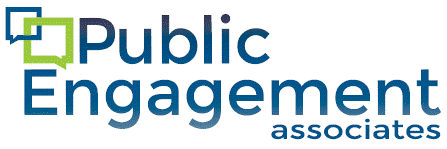PEA and Its Commitment to Racial Equity: Work Along the Purple Line Corridor
- Steve Brigham
- Oct 2, 2023
- 4 min read
Steve Brigham / Blog

When Public Engagement Associates launched in January 2014, all three PEA principals had worked for many years for a national non-profit organization, AmericaSpeaks, which had just closed its doors.
The three of us not only brought deep community engagement experience working on several hundred AmericaSpeaks projects over thirteen years, but we also remained committed to its core principles.
Among those were to:
Ensure a diverse and representative group of residents would weigh in on policy issues in the specific geographies where we worked
Invest the necessary resources to conduct outreach to recruit participants who were historically “hard to reach” because of previous marginalization and disenfranchisement
In subsequent years, we realized that adhering to these principles remained necessary but not sufficient when conducting community engagement.
Undoing the many inequitable and patently unfair policy choices and outcomes from decades past required more than just bringing people to the table to influence new policies. It meant, as well, to place on the table policy options and strategies that intentionally looked to level the playing field for those residents who have often been the casualties of racist, discriminatory, or patently unfair policies – most often people of color - that advantaged wealthier and most often white residents.
In my PEA work since 2018, I have actively supported the Purple Line Corridor Coalition (PLCC), housed at the University of Maryland’s National Center for Smart Growth. The Purple Line will open in 2027 to run from New Carrollton in Prince George’s County to Bethesda in Montgomery County.

The coalition is an innovative public-private-community collaboration working to leverage Maryland’s most significant transit investment in the 21st century to ensure equitable growth for all who live, work, and invest in the corridor.
Ensuring equitable growth is a complex challenge, not done very effectively in any jurisdiction around the U.S. Here’s how we’ve been involved to move an equitable development agenda forward.
Housing for All. In 2019, in partnership with MZ Strategies LLC, PEA conducted an extensive set of multi-stakeholder focus groups and meetings along the corridor to gather baseline input and aspirations to inform an inclusive, 4-year housing plan. This resulted in the coalition’s first Housing Action Plan but also helped to launch the coalition’s Housing Accelerator Action Team to promote policies and projects in both counties along the corridor that embrace the core principle of “Housing for All.”
The HAAT will publish a new multi-year action plan before the end of 2023.
Small Business Action Team. From 2020-2021, PEA worked with the Ochoa Urban Collaborative to convene a Purple Line small business action team (SBAT) to develop and implement a short-term action plan (12-24 months) to prevent the displacement of business owners of color and immigrant business owners from the corridor during redevelopment. The team identified six equity areas, three in each county, between the future Lyttonsville station in Silver Spring (Montgomery County) and the stations in Greater Riverdale (Prince George’s County).
At the same time, the SBAT also published a longer-term, more visionary strategy document for preserving and advancing BIPOC-owned businesses in the corridor.
Equitable Workforce Development Plan. During the pandemic, in 2021-2022, Steve convened stakeholders in the workforce development space along the corridor – from workforce agencies to community colleges to non-profit service providers – to produce an
Initially, this led to the compilation of resources and services for undocumented residents in the corridor and for digital literacy (Spanish version).
This work also led to a collaboration between the coalition and both county library systems to offer a free, eight-week digital skills workshop for corridor residents. This collaboration evolved into a proposal for a comprehensive digital navigation/digital inclusion program for the corridor, which the coalition is still looking to fund.
Equitable Transit-Oriented Development. Last fall, after a two-year process, the coalition published a multi-stakeholder informed “Equitable, Transit-Oriented Development Strategy” for the corridor.
The report analyzes existing corridor conditions and key, equity-focused recommendations in three areas: (1) multimodal accessibility, (2) TOD and Housing, and (3) Economic Development. PEA helped organize and facilitate small and medium-sized, multi-stakeholder convenings throughout the last year of the process, leading to the key findings in the report.
Starting this fall, PEA will be involved in engagement activities for a new, grant-funded group for the coalition that will lead to a report and commitments to pursue equitable mixed-use redevelopment in six future station areas of the corridor. Mixed-use refers to developing both housing and commercial spaces on the same site.

Despite an enormous amount of work the coalition of more than 20 partners has churned out over the past five years, the pressures of gentrification loom large in the corridor as it has rapidly become a magnet for new private investment dollars. The risks of displacement for lower-income and BIPOC residents remain high as it does for long-time small business owners of color in the corridor. PEA is proud of its work with the PLCC and knows that the efforts it makes in the future months and years will be even more crucial to contend against forces that would displace long-time corridor residents and business owners.




Comments